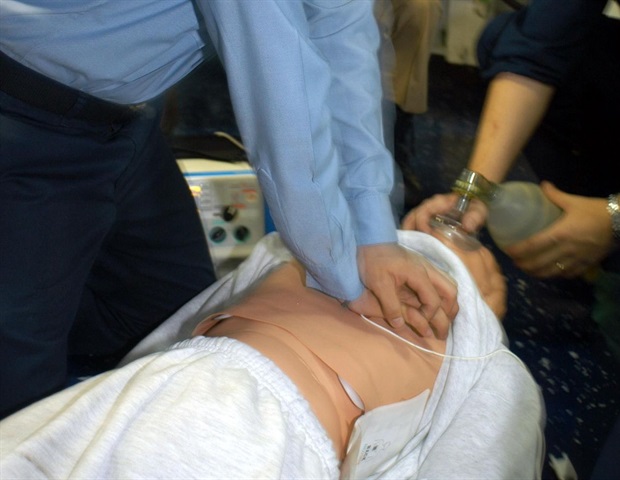
Girls have been much less probably than males to obtain cardiopulmonary resuscitation (CPR) in public, nevertheless, this disparity improved when 911 telecommunicators offered lifesaving directions to callers looking for assist for somebody having a cardiac arrest, in accordance with preliminary analysis to be offered on the American Coronary heart Affiliation’s Resuscitation Science Symposium 2024. The assembly might be held Nov. 16-17, 2024, on the Hilton Chicago Lodge in Chicago and can function the newest advances associated to treating cardiopulmonary arrest and life-threatening traumatic damage.
Cardiac arrest, which happens when the guts malfunctions and abruptly stops beating, is commonly deadly with out fast medical consideration akin to CPR to extend blood stream to the guts and mind. Greater than 357,000 out-of-hospital cardiac arrests occur every year within the U.S. with a 9.3% survival price.
On this research, researchers recognized almost 2,400 out-of-hospital cardiac arrest instances from the Cardiac Arrest Registry to Improve Survival (CARES) from 2022 to 2023. They examined variations between men and women receiving bystander CPR and time measures, together with time to acknowledge the necessity for CPR and time to first compression.
The research discovered:
- When a telecommunicator offered help to a caller by instructing them on the right way to carry out CPR, bystander CPR was given to ladies 44% of the time and 40% of the time to males, in comparison with 9% for ladies and 11% for males when there was no telecommunicator help.
- These variations by intercourse in receiving bystander CPR weren’t statistically vital, indicating there was no substantial distinction between women and men. Nonetheless, they do showcase the essential position of the assist given by a telecommunicator on the telephone throughout a cardiac emergency.
CPR can double a person’s likelihood of survival. The findings from our analysis are according to related outcomes from a research performed in Korea. Earlier analysis has proven that hesitance could also be a purpose ladies are much less probably than males to obtain CPR in public. Among the considerations recognized have been considerations about touching a lady’s chest through the lifesaving approach or concern the motion might be perceived as assault.”
Audrey Blewer, Ph.D., M.P.H., research’s lead writer and assistant professor within the departments of household medication and neighborhood well being and inhabitants well being sciences within the Colleges of Medication and the College of Nursing at Duke College in Durham, North Carolina
Blewer famous their most up-to-date findings assist assist the thought that there’s a want for extra advocacy to assist neighborhood emergency response, and the position of the telecommunicator is essential and might be instrumental in lowering identified intercourse disparities. This research highlights the significance of the primary hyperlink within the out-of-hospital cardiac arrest chain of survival -; activation of the emergency response system.
The evaluation additionally discovered:
- Bystander CPR was administered in 52% of cardiac arrests occurring exterior of a hospital. Of those instances, 81% have been carried out with telecommunicator help in comparison with 19% have been offered with out help.
- The median time from name acquired to the telecommunicator recognizing the necessity for CPR was 87 seconds (one minute and 27 seconds) for each men and women.
- The median time to first compression from the time the telecommunicator acquired the decision was 204 seconds (three minutes and 24 seconds) for ladies, in comparison with 207 seconds (three minutes and 27 seconds) for males.
“Everybody who experiences a cardiac arrest ought to have an equal alternative to obtain CPR,” Blewer mentioned. “We’re doing every thing we are able to to analysis methods to handle this identified inequity affecting ladies. We hope that our analysis will assist shut this hole sooner or later. Most significantly, our findings show if anybody encounters an individual in cardiac arrest, it’s important that they name 911 instantly and push onerous and quick on the middle of the particular person’s chest.”
“Taking motion will assist elevate consciousness, enhance bystander CPR and enhance survival from cardiac arrest,” she mentioned.
A limitation of the research is that it’s a secondary evaluation of a bigger, ongoing medical trial, which minimized its pattern measurement. There’s a restrict in generalizability as a result of the information is from North Carolina, findings could also be completely different for individuals dwelling in different states.
Research particulars and background:
- Amongst individuals whose cardiac arrest instances have been examined, the common age was 63 years previous, 67% have been white and 37% have been ladies.
- The research used knowledge from the Randomized Cluster Analysis of Cardiac Arrest Programs, a seven-year trial led by the Duke Medical Analysis Institute centered on enhancing outcomes for out-of-hospital cardiac arrest victims.
- The trial collected info for 8,839 out-of-hospital cardiac arrest instances from July 2022 by means of December 2023 overlaying 52 North Carolina counties, about half of the state.
- Researchers recognized 2,398 of the instances of out-of-hospital cardiac arrests for his or her evaluation, after excluding pediatric, traumatic and well being care facility cardiac arrests and people witnessed by emergency medical providers.

